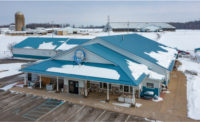Moo-Ville Creamery is pushing the butterfat limits
The dairy processor relies on modern equipment and local ingredients to produce super-premium ice cream that’s between 16% and 17% butterfat.

Moo-Ville Creamery’s 10,000-square-foot plant can produce 400 gallons per hour of high-butterfat, super-premium hard ice cream, as well as soft-serve mix.
Nashville, Tenn., is known as “Music City.” But another Nashville — one situated in the state of Michigan — could be referred to as “Ice Cream City.” After all, Moo-Ville Creamery produces 60 flavors of the cold, creamy treat in this tiny village of just over 1,600 residents.
Opened in 2005 by the Westendorp family — who also operate WestVale-View Dairy in Nashville — the 10,000-square-foot plant can produce 400 gallons per hour of high-butterfat, super-premium hard ice cream, as well as soft-serve mix. (The Moo-Ville Creamery plant also processes homogenized and cream-line milk, butter, and cheese; see the Processor Profile.) The milk from the plant is supplied by WestVale-View Dairy cows, which produce only easier-to-digest A2A2 milk.
The road to ice cream
During Dairy Foods’ visit, the plant was producing a couple flavors of ice cream, including Moo-Ville Creamery’s No. 1 selling ice cream: Sea Monster. The product combines sea salt caramel ice cream with Oreo cookies and cookie dough.
Ice cream production begins with milk being gravity-fed to the plant from the dairy farm, which is only 400 feet from the plant, explains Levi Westendorp, co-owner and son of the creamery’s founders, Doug and Louisa Westendorp. The milk is run through a separator, and the milk and cream are combined with Michigan-sourced beet sugar, dry skim powder, and an emulsifier and stabilizer base made for Moo-Ville Creamery.


“After homogenizing and pasteurizing through an HTST, we let it age overnight,” Levi Westendorp notes. “We then blend real caramel into the ice cream mix and add a touch of salt before [the mix goes] through the continuous ice cream machine.”
Finally, an ingredient feeder blends real Oreo cookie and cookie dough pieces into the mix before the ice cream is hardened and readied for packaging, he says. Packaging formats for Moo-Ville Creamery’s super-premium hard ice cream include 3-gallon containers (60 flavors), 48-ounce cartons (36 flavors), and pints (eight flavors).
Upgrades galore
Moo-Ville Creamery long relied on three batch freezers for ice cream production. About three years ago, however, the plant installed three Tetra Pak continuous units, as well as a new Tetra Pak ingredient feeder and a Martin Brothers ripple pump, notes Troy Westendorp, also a co-owner and son of Doug and Louisa Westendorp.

“We also added over 1,000 square feet of freezer storage when adding the new equipment,” he says.
The upgraded machines not only are easy to use, but also allow changes in overrun, viscosity, and rate of inclusion addition to be made via a touch screen, Troy Westendorp points out.
“Variability and consistency were always hard to control in batch machines, and even though we had if figured out down to a science, nothing compares to the consistency of a continuous setup,” he stresses.

Other recent upgrades include a new freezer, installed two years ago, that can go down to approximately -50 degrees Fahrenheit in terms of wind chill, Troy Westendorp adds.
“We kept increasing the size of it when we were designing it, but it still wasn’t enough,” he notes. “It seems like no matter how big you build a cooler or freezer, it is never big enough!”
Different by design
The modern equipment might allow Moo-Ville Creamery to better compete with other regional ice cream makers, but that doesn’t mean the company aims to be like those processors in other ways. The company and its plant are decidedly different by design. For one thing, Moo-Ville ice cream features 16% to 17% butterfat content, which Troy Westendorp contends “is pushing the limits.”

“But we also know that’s what sets us apart from our competition,” he says, “and gives our ice cream the smooth-textured feel we are looking for.”
The A2A2 milk produced by the dairy’s cows is another differentiator. The Westendorp family converted its 200-cow herd to all A2A2-producing cows back in March 2022, Troy Westendorp notes.
“All of our milk has been bottled with an A2A2 sticker on [it] since then, and we continue to get people who haven’t drank milk in years to try our milk,” he says. “[They are] shocked when they have no digestive problems. My dad was the driving force behind switching everything to A2AS, and we think A2A2 is the future of dairy.”
The fact that the A2A2 milk is gravity-fed from the farm to the creamery also sets the company apart from others.
“We try to keep our products as close to [their] wholest form with as minimal processing as we have to,” Troy Westendorp explains. “We also are always under a 100,000 somatic cell count. That allows us to put 25 ‘best buy’ days on our milk.”
Moo-Ville’s core team of seven plant employees — working across one production shift — is yet another differentiator. According to Troy Westendorp, the team has been together for several years, and “everyone knows what’s going on and how things need to be done.”
That doesn’t mean the plant is without its challenges, of course. Although Moo-Ville Creamery is fortunate in that it’s now large enough to allow it to order most ice cream ingredients by the pallet, directly from the manufacturer, lead times have increased since the advent of the COVID-19 pandemic, Troy Westendorp says. So it’s often necessary to order more of an ingredient ahead of when it’s needed.
“Running out of an ingredient creates chaos,” he explains. “So while we do have a decent-size freezer for ingredient storage, it does get tight in there at times.”
Looking for a reprint of this article?
From high-res PDFs to custom plaques, order your copy today!






.jpg?height=200&t=1630591584&width=200)